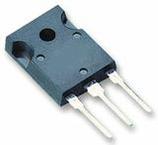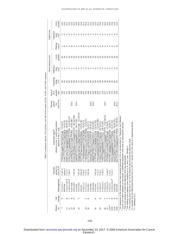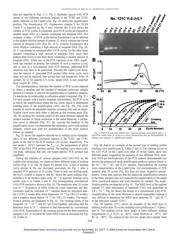Datasheet 搜索 > 双极性晶体管 > ON Semiconductor(安森美) > MJW3281AG 数据手册 > MJW3281AG 其他数据使用手册 5/10 页

¥ 16.265
MJW3281AG 其他数据使用手册 - ON Semiconductor(安森美)
制造商:
ON Semiconductor(安森美)
分类:
双极性晶体管
封装:
TO-247-3
描述:
互补NPN -PNP硅功率双极晶体管 Complementary NPN-PNP Silicon Power Bipolar Transistors
Pictures:
3D模型
符号图
焊盘图
引脚图
产品图
页面导航:
原理图在P2
导航目录
MJW3281AG数据手册
Page:
of 10 Go
若手册格式错乱,请下载阅览PDF原文件

1.2 or 3.39. The program consisted of the following three steps. The first step
was an initial denaturation where the reaction was incubated for 2 min at 95°C.
In the second step, DNA was amplified for 35 cycles of1sat95°C, 10 s at
50–65°C, and 10 s at 72°C. Finally, the temperature was raised gradually
(0.2°C/s) from the annealing temperature to 95°C for the melting curve
analysis. If the sensitivity did not reach a level of 10
⫺4
leukemic cells, an
additional 10 cycles were performed before completion of the amplification
program (version 3.39).
Prevention of Cross-Contamination. The PCR mixtures were prepared in
a closed room separated from any PCR product (pre-PCR room). After the
PCR mixture was prepared, the pipettes and stands that were only used in
the pre-PCR room were placed under UV light for 15 min. All other steps of
the analyses were performed in another post-PCR room.
RESULTS
Characterization of Junctional Regions. Twenty-five ALL pa-
tients were analyzed with a panel of PCR primers that are able to
detect ⬎90% of possible IGH, IGK, TCRD, and TCRG gene rear-
rangements (2, 4, 22). A total of 84 immunoglobulin/TCR rearrange-
ments were detected, comprising 17 IGH gene rearrangements in 14
cases, 16 IGK rearrangements in 11 cases, 19 TCRD rearrangements
in 13 cases, and 32 TCRG rearrangements in 18 cases, respectively.
All patients exhibited at least two suitable markers (range, 2–6
markers/patient; average, 3.4 markers/patient).
To assess the sensitivity and practicability of ASO-PCR by the
LightCycler technology, we investigated 35 junctional regions of
immunoglobulin/TCR genes from these 25 ALL patients (Tables 2
and 3). They comprised 11 IGH (1 V
H
1-J
H
,8V
H
3-J
H
, and 2 V
H
4-J
H
),
6 IGK (1 V
I-Kde, 2 V
II-Kde, 1 V
III-Kde, 1 V
IV-Kde, and 1
RSS-Kde), 6 TCRD (2 V
␦
2-D
␦
3,1D
␦
2-D
␦
3,1D
␦
2-J
␦
1,1V
␦
1-D-
J
␦
1, and 1 V
␦
2-D-J
␦
1), and 12 TCRG (7 V
␥
I-J
␥
1.3/2.3, 1 V
␥
II-J
␥
1.3/
2.3, 2 V
␥
III-J
␥
1.3/2.3, 1 V
␥
I-J
␥
2.1, and 1 V
␥
IV-J
␥
1.1) rearrange-
ments. The mean number of nucleotides inserted at the junctional
regions was 19.3 (range, 12–30) for IGH loci, 5.8 (range, 4–8) for
IGK, 10.0 (range, 5–23) for TCRD, and 6.7 (range, 2–10) for TCRG,
and the mean number of nucleotide deletions was 10.0 (range, 0–32)
for IGH, 17.0 (range, 9–42) for IGK, 22.0 (range, 0–67) for TCRD,
and 14.0 (range, 2–62) for TCRG. The mean size of the PCR product
was 174 bp (range, 106–239 bp).
ASO-PCR on a Block Thermocycler. To compare ASO-PCR
data obtained by the LightCycler technology with conventional ASO-
PCR data, we analyzed 35 ASO-PCRs on a conventional block
thermocycler (Tables 2 and 3). The conventional ASO-PCR revealed
a detection limit of 10
⫺3
in 2 cases (6%), 10
⫺4
in 16 (46%), 10
⫺5
in
15 (43%), and 10
⫺6
in 2 (6%). The mean number of cycles optimal for
MRD analysis of IGH rearrangements (end point) was 28, whereas
that for IGK/TCRD/TCRG was 23. The mean number of ASO-PCR
experiments necessary for the determination of the optimal end point
was 3.7.
ASO-PCR on the LightCycler. Representative results of ASO-
PCR on the LightCycler and a comparison with conventional PCR
Fig. 2. ASO-PCR data from patients 32 and 17 on the LightCycler. A, melting curve analyses (1E-1,10
⫺1
dilution; 1E-5,10
⫺5
dilution; 1E-6, 10
⫺6
dilution). B, amplification profile
(1E-1,10
⫺1
dilution; 1E-2,10
⫺2
dilution, and so on). C, calibration graph.
3285
QUANTIFICATION OF MRD IN ALL PATIENTS BY LIGHTCYCLER
Research.
on December 23, 2017. © 2000 American Association for Cancercancerres.aacrjournals.org Downloaded from
器件 Datasheet 文档搜索
AiEMA 数据库涵盖高达 72,405,303 个元件的数据手册,每天更新 5,000 多个 PDF 文件







